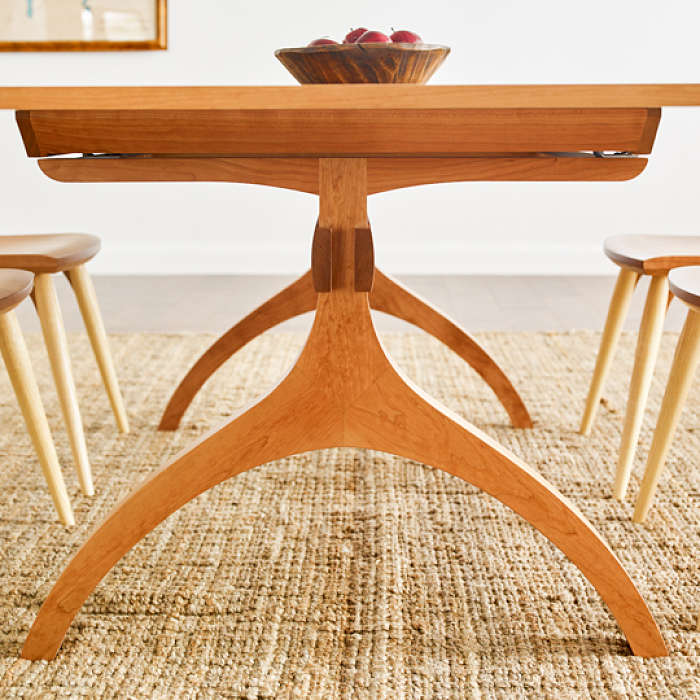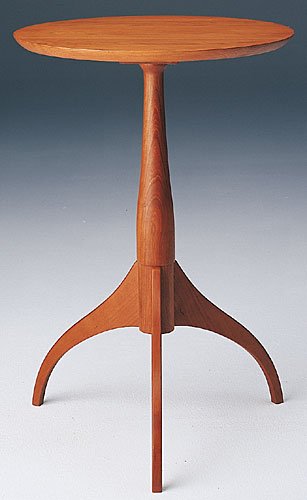Steve Maskery
Established Member
I've been without a proper dining table for several years, making do with an old and small, octagonal, mahogany table that always stood in my grandparents' window with a vase of flowers on it. It's fine for one, OK for two but too cosy for comfort with any more.
I've had a design in my head for quite a while, but had never got round to realising it.


Last year I saw a table top for sale. Nice pippy oak, too big for my needs, but, I thought, it would save me some work preparing large boards with my small machines. So I bought it.
Big, big mistake. It was badly jointed, slathered in a horrible poly finish, patched in a couple of places and very, very cupped. It also arrived damaged. Nothing that would affect me, but it's an indication of the situation. It was going to be more work in putting this right that buying virgin timber. Plus, I paid far too much money for it. Ah well, we live and learn.
The good news is that it is very pretty.
So the first task was to cut down the centre, to see where the Dominoes were, and therefore where it was, and was not, safe to crosscut. I could get a nice, quite well-balanced top, 1400mm long.
The next task was to straighten up the balance of the grain. The two boards were quite well balanced at one end

but miles out at the other.

So I cut out a long thin triangle to bring the two haves more into balance.

I could now see that I could get a top slightly over 800mm wide.
All this cutting was done with my tracksaw swapping between rip and cross-cut blades as necessary. Good job it has a FastFix feature, it really is a quick job and stops me from thinking that it's not worth changing the blade again just for one cut. I ended up with two decently-matched boards 1400 x 400mm.

However, they were still far from flat. I do have a drum sander, but it is not up to the task of handling boards of this size. To cut a long story short, I rang my woody pal Andy and asked if I could use his big drum sander and he very kindly agreed to help me out. If you are reading this, Andy, thank you very much indeed.

It took two of us two hours to get them flat and uniform. The bad news is that we have removed 4mm of wood (down from 32mm to 28mm – still a generous thickness for a table top), but one board has become slightly more heavily pippied (is that even a word?) than it was, while the other has got a bit less pippy than it was, so the contrast between the two halves has increased.
There are a couple of places where there is a very large difference in figure between the two boards. One I can't do anything about, the other I can. More tomorrow.
Possibly.
I've had a design in my head for quite a while, but had never got round to realising it.


Last year I saw a table top for sale. Nice pippy oak, too big for my needs, but, I thought, it would save me some work preparing large boards with my small machines. So I bought it.
Big, big mistake. It was badly jointed, slathered in a horrible poly finish, patched in a couple of places and very, very cupped. It also arrived damaged. Nothing that would affect me, but it's an indication of the situation. It was going to be more work in putting this right that buying virgin timber. Plus, I paid far too much money for it. Ah well, we live and learn.
The good news is that it is very pretty.
So the first task was to cut down the centre, to see where the Dominoes were, and therefore where it was, and was not, safe to crosscut. I could get a nice, quite well-balanced top, 1400mm long.
The next task was to straighten up the balance of the grain. The two boards were quite well balanced at one end

but miles out at the other.

So I cut out a long thin triangle to bring the two haves more into balance.

I could now see that I could get a top slightly over 800mm wide.
All this cutting was done with my tracksaw swapping between rip and cross-cut blades as necessary. Good job it has a FastFix feature, it really is a quick job and stops me from thinking that it's not worth changing the blade again just for one cut. I ended up with two decently-matched boards 1400 x 400mm.

However, they were still far from flat. I do have a drum sander, but it is not up to the task of handling boards of this size. To cut a long story short, I rang my woody pal Andy and asked if I could use his big drum sander and he very kindly agreed to help me out. If you are reading this, Andy, thank you very much indeed.

It took two of us two hours to get them flat and uniform. The bad news is that we have removed 4mm of wood (down from 32mm to 28mm – still a generous thickness for a table top), but one board has become slightly more heavily pippied (is that even a word?) than it was, while the other has got a bit less pippy than it was, so the contrast between the two halves has increased.
There are a couple of places where there is a very large difference in figure between the two boards. One I can't do anything about, the other I can. More tomorrow.
Possibly.
Last edited:




































